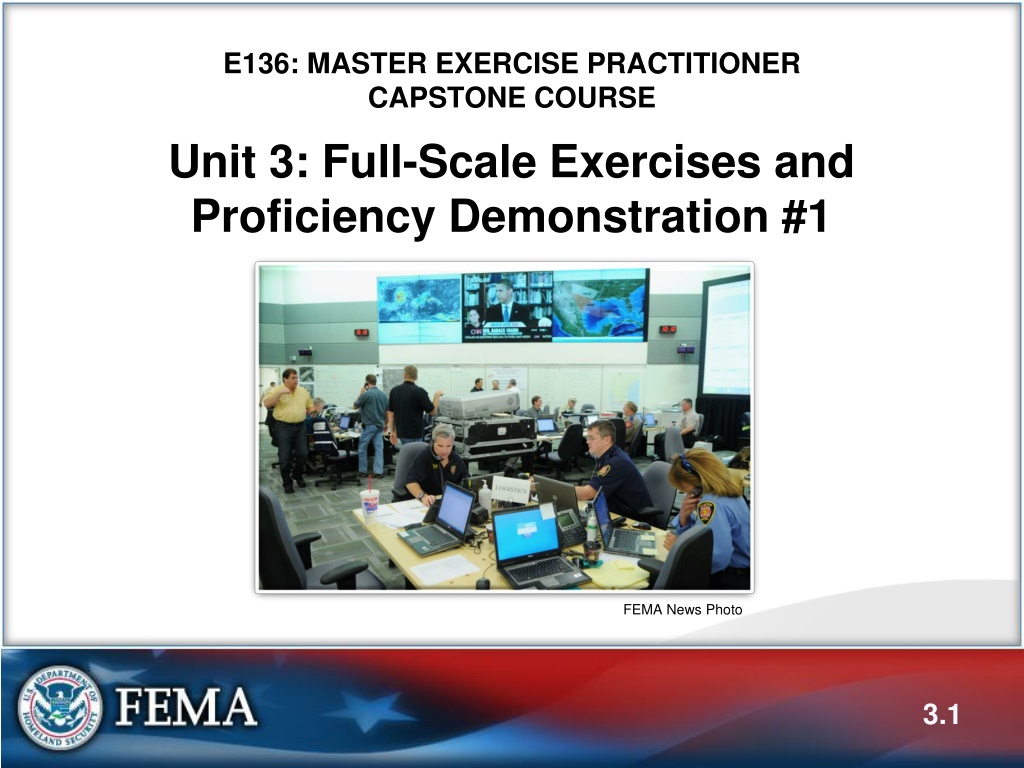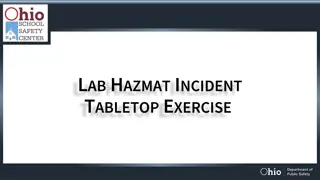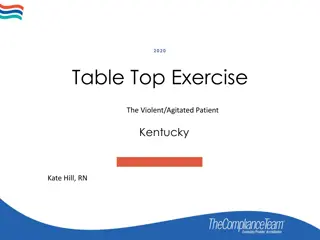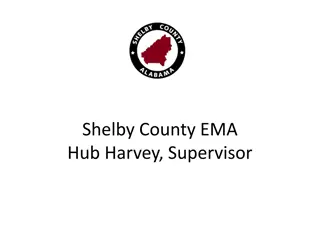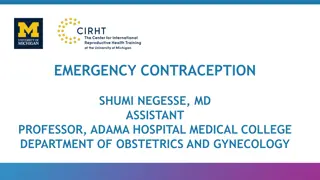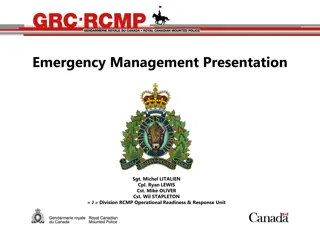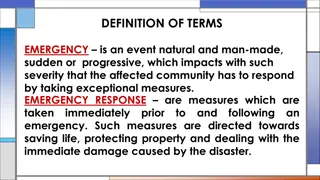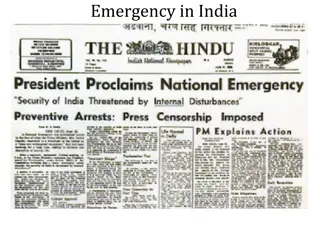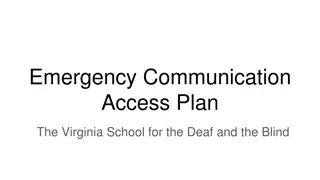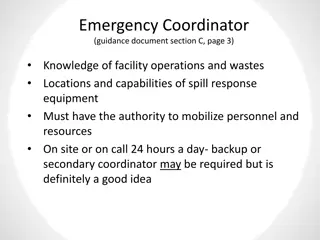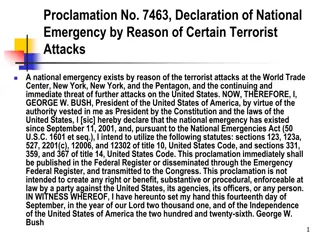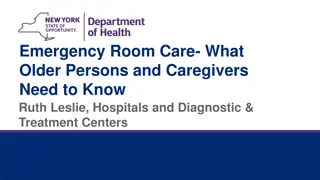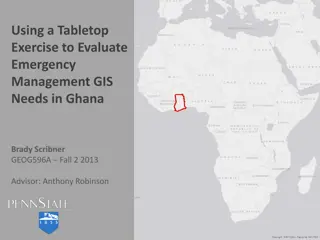Characteristics and Importance of Full-Scale Exercises in Emergency Management
Full-Scale Exercises (FSEs) are comprehensive and resource-intensive activities involving multiple agencies and organizations to test preparedness and response capabilities. Participants operate under unified command systems, enhancing coordination and problem-solving skills in a simulated yet realistic environment. Safety of responders is crucial during FSEs to ensure effective training outcomes.
Download Presentation

Please find below an Image/Link to download the presentation.
The content on the website is provided AS IS for your information and personal use only. It may not be sold, licensed, or shared on other websites without obtaining consent from the author. Download presentation by click this link. If you encounter any issues during the download, it is possible that the publisher has removed the file from their server.
E N D
Presentation Transcript
E136: MASTER EXERCISE PRACTITIONER CAPSTONE COURSE Unit 3: Full-Scale Exercises and Proficiency Demonstration #1 PHOTO: Emergency management personnel work in an EOC. FEMA News Photo 3.1
Unit Objectives Describe the characteristics of a full-scale exercise (FSE) Describe how the HSEEP Exercise Cycle applies to an FSE Identify the exercise participants utilized in an FSE and their roles/responsibilities Identify benefits and challenges of an FSE 3.2
Unit Objectives (contd.) Apply the roles and responsibilities of players, controllers, simulators, actors, and evaluators in an FSE environment Develop an AAR/IP for an FSE 3.3
What is a Full-Scale Exercise? FSEs are typically the most complex and resource-intensive type of exercise: Involving multiple agencies, organizations, and jurisdictions, and validate many facets of preparedness Including many players operating under cooperative systems such as the Incident Command System or Unified Command 3.4
What is a Full-Scale Exercise? (contd.) Discussion: How do FSEs differ from FEs? 3.5
What is a Full-Scale Exercise? (contd.) Players are mobilized/deployed to the designated response area where they respond in a free-play environment Players use problem solving skills and critical thinking to determine what steps to take 3.6
What is a Full-Scale Exercise? (contd.) Players respond as if it were an actual incident with minimal interference from controllers or evaluators Responders wear appropriate gear/PPE There should be minimal simulation If something is not to be demonstrated, it should be documented in the Exercise Plan (ExPlan), under Assumptions and Artificialities 3.7
What is a Full-Scale Exercise? (contd.) SAFETY is a paramount issue! Responders can be injured in field response play A dedicated Safety Officer should be designated Players should also designate a Safety Officer as part of the ICS If possible, have a dedicated EMS unit 3.8
What is a Full-Scale Exercise? (contd.) The exercise will typically be conducted in multiple locations: Command locations (e.g., ICP) Field activity locations Support locations (e.g., hospitals) EOC Actual locations are preferred, but substitute locations can be used 3.9
What is a Full-Scale Exercise? (contd.) Discussion: What are some other locations in which an FSE can be conducted? Video: http://link.backlight.tv/innguard/videos/muscatatuck- urban-training-center-information-video-367.html 3.10
The HSEEP Exercise Cycle and FSEs GRAPHIC: A graphic showing the HSEEP Exercise Cycle. Design and Development leads to Conduct, which leads to Evaluation, Which leads to Improvement Planning, which leads back to Design and Development. 3.11
Design and Development Phase Base improvements on input from previous exercises Review exercise needs assessment for accuracy Assess capability to conduct an FSE Address costs and liabilities usually higher Gain support and announce the exercise GRAPHIC: A graphic showing the HSEEP Exercise Cycle. Design and Development leads to Conduct, which leads to Evaluation, Which leads to Improvement Planning, which leads back to Design and Development. 3.12
Design and Development Phase (contd.) Apply the Eight Exercise Design Steps: 1. Assess needs 2. Define the scope 3. Write a statement of purpose 4. Define objectives 5. Compose a narrative 6. Write major and detailed events 7. List expected actions 8. Prepare messages 3.13
Design and Development Phase (contd.) Conduct exercise planning meetings Concept and Objectives (C&O) Meeting Initial Planning Meeting (IPM) Midterm Planning Meeting (MPM) Master Scenario Events List (MSEL) Meeting (optional can be done during MPM) Final Planning Meeting (FPM) NOTE: Multiple site visits and additional meetings may also be necessary 3.14
Design and Development Phase (contd.) Develop the necessary documentation for an FSE: Exercise Plan (ExPlan) Controller/Evaluator Handbook (C/E Handbook) MSEL Exercise Evaluator Packets (EEGs, plans, maps) Communication plan Briefing materials Participant feedback forms 3.15
Design and Development Phase (contd.) Identify exercise participants: Players Actors Exercise Director Senior Controller Controller Venue Controller (Field) Safety Controller Simulator Evaluators 3.16
Design and Development Phase (contd.) Players Individuals who have an active role in responding to the simulated emergency and perform their regular roles and responsibilities during the exercise Initiate actions that will respond to and mitigate the simulated emergency 3.17
Design and Development Phase (contd.) Actors Exercise participants who act or simulate specific roles during exercise play Typically volunteers who have been recruited to play the role of victims or other bystanders 3.18
Design and Development Phase (contd.) Exercise Director Plans, coordinates, and oversees all exercise functions Manages the exercise activities Maintains a close dialogue with the Senior Controller regarding the status of play and the achievement of the exercise design objectives 3.19
Design and Development Phase (contd.) Senior Controller Is responsible for the overall organization of the exercise and exercise setup Takes direction from the Exercise Director Monitors exercise progress and coordinates decisions regarding deviations or significant changes to the scenario Is the eyes and ears for the Exercise Director 3.20
Design and Development Phase (contd.) Senior Controller (cont d.) Monitors actions by individual controllers/simulators and ensures they implement all designated and modified actions at the appropriate time Debriefs the controllers and evaluators after the exercise and oversees the setup and takedown of the exercise 3.21
Design and Development Phase (contd.) Controllers Plan and manage exercise play Set up and operate the exercise incident site When necessary, take on the roles of individuals and agencies not actually participating in the exercise Direct the pace of exercise play Provide key data to players May prompt or initiate certain player actions and injects to ensure exercise continuity 3.22
Design and Development Phase (contd.) Controllers (cont d.) Issue exercise materials to players as required Monitor the exercise timeline Supervise the safety of all exercise participants Are the only participants who should provide information or direction to players Are accountable to one Senior Controller 3.23
Design and Development Phase (contd.) Venue Controller (Field) Assists the Senior Controller in the overall organization of the exercise Is a direct report to the Senior Controller Monitors exercise progress and coordinates decisions to the Senior Controller regarding deviations or significant changes to the scenario caused by field venue during the exercise 3.24
Design and Development Phase (contd.) Discussion: What are the potential consequences if scenario deviations or changes are not communicated to the Senior Controller? 3.25
Design and Development Phase (contd.) Safety Controller Reports to Exercise Director Monitors exercise safety during setup, conduct, and cleanup of the exercise All exercise participants will assist the Safety Controller by reporting any safety concerns 3.26
Design and Development Phase (contd.) Simulators Role-play as nonparticipating organizations or individuals Provide injects to the players as described in the MSEL, at the direction of the Senior Controller Function semi-independently under the supervision of SimCell controllers Are ultimately accountable to the Exercise Director and Senior Controller 3.27
Design and Development Phase (contd.) Discussion: From where do you get evaluators? 3.28
Design and Development Phase (contd.) Evaluators Work as a team with control staff Can come from the exercise planning team Can be subject-matter experts Record events and submit documentation for review and inclusion in the After-Action Report (AAR) Should not have any direct interaction with the players Specific evaluator responsibilities are addressed in the C/E Handbook 3.29
Design and Development Phase (contd.) Plan for community impact Street closures Business disruptions Misinformation and rumors Main Street is on fire! Always include This is an exercise PHOTO: A police department holds a full- scale exercise that utilizes an armored personnel carrier. FEMA News Photo 3.30
Design and Development Phase (contd.) Discussion: What negative impacts could be anticipated if the disclaimer statement, This is an exercise, is not included in public communications? In addition to street closures and potential business disruptions, what are some other aspects of the exercise about which you may want to inform the public? 3.31
Design and Development Phase (contd.) Other Considerations: Weather conditions Real world vs. simulated Wind direction and speed may need to be simulated Date and time Exercise date and time affect exercise play Population demographics Weekday vs. weekend Morning vs. night 3.32
Design and Development Phase (contd.) Discussion: How can you accommodate for weather conditions that do not sync with your testing needs? 3.33
Design and Development Phase (contd.) Other Considerations (cont d.): Exercise assembly area Deployment timetable Developed before the exercise Used to release emergency response units according to their actual travel time from their home stations Allows for exercise artificialities 3.34
Design and Development Phase (contd.) Exercise site management: SAFETY! Logistics: water, restroom facilities, parking, etc. Exercise assembly areas, props, etc. Simulator (victim) staging, rehab Simulator management of props (smoke, sound effects, etc.) Check-in/check-out system Badging, as appropriate 3.35
Design and Development Phase (contd.) Safety Define role of Safety Officers ICS Safety Officer responsibilities Ensure they are identified (vests, arm bands, etc.) Ensure they are familiar with the exercise scenario Place in high-risk area Have a communications safety network in place for reporting safety issues PHOTO: Rescue workers transport a person on a stretcher during an exercise. FEMA News Photo 3.36
Design and Development Phase (contd.) Emergency Call-Off Real-world emergencies can and do occur during exercises Real-world emergencies are a first priority Could be on-site or off-site Exercise may be cancelled or put on hold until situation is resolved A pre-arranged code word should be briefed to all exercise participants 3.37
Design and Development Phase (contd.) Discussion: What code words have you used to cancel or call off an exercise? 3.38
Exercise Conduct Phase To conduct a successful exercise: Show up on time Read briefing materials Understand roles/responsibilities Foster realism Test communications Test equipment and gear Stay in your role GRAPHIC: A graphic showing the HSEEP Exercise Cycle. Design and Development leads to Conduct, which leads to Evaluation, Which leads to Improvement Planning, which leads back to Design and Development. 3.39
Exercise Conduct Phase (contd.) Exercise play rules: Establish the parameters that participants follow Describe appropriate behavior when: Physical contact is necessary Participant actions become overemotional or excessive Do not fight the scenario PHOTO: Emergency responders practice in full HAZMAT gear. FEMA News Photo 3.40
Exercise Conduct Phase (contd.) Exercise play rules (cont d.): Established before the exercise to prevent physical harm and property damage Written rules should be provided to all parties in advance when victim/actor play is involved 3.41
Exercise Conduct Phase (contd.) Exercise play rules (cont d.): Documented in Extent of Play Agreements (XPAs) XPAs: Are formed between exercise participants and the exercise sponsor Define the organizations participating in the exercise as well as their extent of play Are vital to the planning of the exercise, recruitment of evaluators, and development of support requirements Sample XPA Handout, shared drive 3.42
Design and Development Phase (contd.) Discussion: Who has worked with outside agencies/departments that required an XPA? What was your experience? 3.43
Exercise Conduct Phase (contd.) Exercise Staff All staff (Controllers, Simulators, and Evaluators) should keep logs Exercise packets should be issued Radios and recording devices may be issued All should have distinctive identification o Badges, armbands, hats, T-shirts, etc. 3.44
Exercise Evaluation Phase Player Hot Wash Should occur immediately after exercise conduct Includes completing the participant feedback forms Controller/Evaluator Debriefing Should occur as soon as possible after EndEx No player involvement Draft AAR GRAPHIC: A graphic showing the HSEEP Exercise Cycle. Design and Development leads to Conduct, which leads to Evaluation, which leads to Improvement Planning, which leads back to Design and Development. 3.45
Improvement Planning Phase Follow up on AAR corrective actions that are listed in the Improvement Plan (IP) GRAPHIC: A graphic showing the HSEEP Exercise Cycle. Design and Development leads to Conduct, which leads to Evaluation, Which leads to Improvement Planning, which leads back to Design and Development. 3.46
Improvement Planning Phase (contd.) Discussion: If the agency responsible for a corrective action is outside of your area of control/responsibility, what strategies can be implemented to inquire about progress or completion of an improvement? 3.47
FSE Benefits Realism; simulates real-world response Fully validates plans/policies/procedures Tests equipment Validates lessons learned from previous exercises Strengthens whole community relationships Creates public awareness Verifies capabilities 3.48
Improvement Planning Phase (contd.) Discussion: What are some other benefits of an FSE? 3.49
FSE Challenges Exercise can take a life of its own Go into left field Deal with issues not intended Weather does not always cooperate Rain Wind direction Extreme temperature Safety concerns Time conducted (daytime vs. nighttime) 3.50
